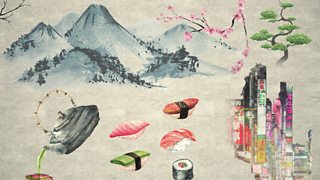Broken a pot? Copy the Japanese and fix it with gold
Nothing is ever truly broken - that's the philosophy behind the ancient Japanese art of Kintsugi, which repairs smashed pottery by using beautiful seams of gold. To celebrate BBC Four's Japan season, MERCEDES SMITH explains how this 500-year-old technique not only restores functionality to broken pots, but is a useful lesson for life.
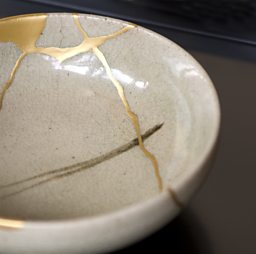
When my children reach eighteen, standing on the cusp of adulthood, I know exactly what I know what I want to give them - a broken pot. It doesn't sound as strange as you think, as it will actually be the gift of optimism epitomised in a fractured vessel that's been fused back together with precious gold.
The technique is the ancient art of Japanese Kintsugi, a powerful metaphor for life where nothing is ever truly broken.
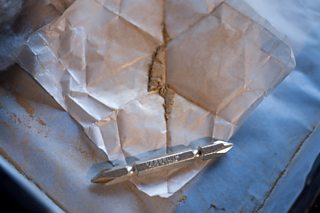
The story of Kintsugi is said to have begun in the 15th century when Japanese military commander Ashikaga Yoshimasa broke one of his beloved Chinese tea bowls and, disappointed with the shoddy repair job it was treated to, urged Japanese craftsmen to come up with a more pleasing method of repair.
In the 500 year old art of Kintsugi, which translates more or less as ‘joining with gold’, broken pottery is repaired with a seam of lacquer and precious metal. Trust the Japanese to encapsulate the wisdom of the ages into a single object. Theirs is a culture with an enviable talent for clarity of both thought and communication, and with an admirable attitude to what really matters in life.
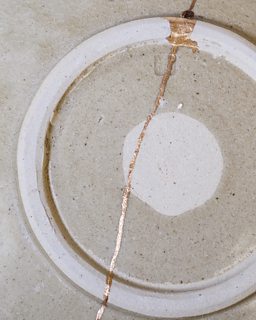
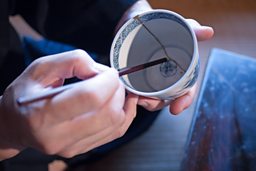
The subsequent Kintsugi approach of emphasising rather than hiding damage illustrates a key difference between eastern and western philosophy. Kintsugi beautifies the breakage and treats it as an important part of the object’s history, and the broken pot not as something to discard, but as something more precious than it was before.
This idea of celebrating the broken pot is an extension of the idea of wabi-sabi which, in contrast to western values of perfection and symmetry, is an eastern philosophy of living that finds beauty in the damaged or imperfect.

Western interest in Kintsugi pottery has increased over the last ten years, perhaps in response to changing attitudes to mass production, consumption and waste. Domestic recycling has led logically to the ‘upcycling’ of vintage and contemporary objects, and there is a growing market for damaged or age worn items that have been polished up, improved or altered to make some new, fascinating art piece.
Despite being a highly visual technique, Kintsugi draws attention to the life, rather than the look of a pot
Pottery has benefited hugely from this attitude to broken things, as evidenced by a glut of recent art shows in which makers are upcycling their hearts out and producing wonderfully curious and refreshingly new ceramic works.
Despite being a highly visual technique, Kintsugi draws attention to the life, rather than the look of a pot. Think of it: you imagine, then craft a gorgeous pot, and it leaves your hands and begins a life with other people, in a different place, and is used by a family, perhaps generations of that family, or is gifted to a loved one, taken overseas, or left alone for years in a cupboard before being brought out, dusted off, and adored as a ‘family’ piece, the facts of its history totally forgotten.
Then some rampant toddler makes a grab for it and oh dear, it’s a gonner, smashed to pieces on the floor. To throw the pot away is to destroy its unique story. To repair it the Kintsugi way is to continue its tale of adventure and triumph.
Life is our own tale of adventures and triumphs. I hope when my daughters encounter the real trials of life, they will look at their Kintsugi pots and won’t be afraid to show their scars and say ‘I have already had a life, but I’m totally up for another, because there really is so much more to me now than there was before.’
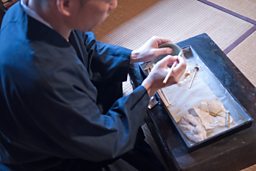
The Great Pottery Throwdown
-
![]()
Join Sara Cox and ceramic experts Kate Malone and Keith Brymer Jones
Filmed at Stoke-on-Trent, the undisputed home of pottery, 10 clay enthusiasts compete to be Britain's top potter
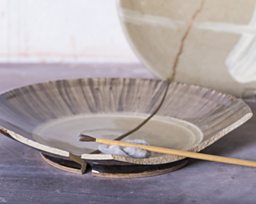
A creative perspective
-
![]()
Fuel your creativity
Tips and ideas on how to get involved with the visual arts
Johnny Vegas' pottery challenge
More pottery on the BBC
BBC Four's Japan Season
-
![]()
Preview: The Art of Japanese Life
Watch a preview of the new series from art historian, Dr James Fox.
-
![]()
BBC Four's Japan idents
A series of three idents specially created for the Japan Season, starting 12 June 2017.
-
![]()
BBC Japan Season
Find out everything you need to know about the three weeks of programming on the art and culture of Japan.








